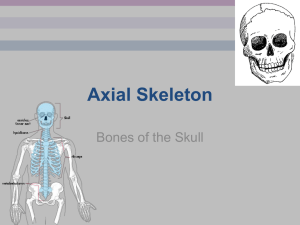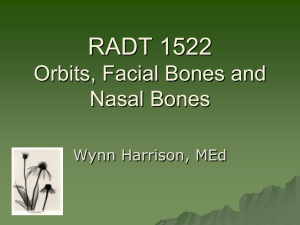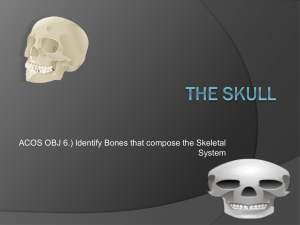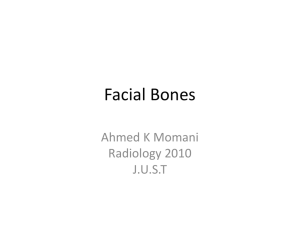Chapter 12
advertisement
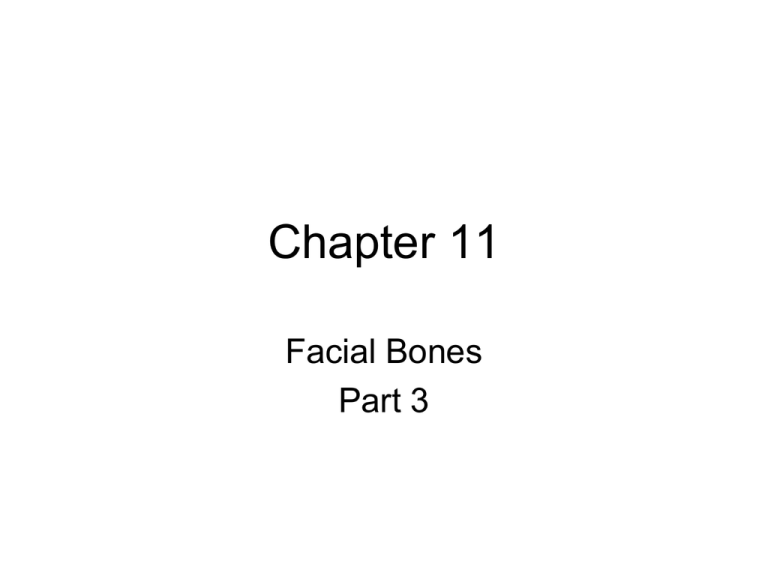
Chapter 11 Facial Bones Part 3 Facial Bones 14 Bones • • • • • • • • 2 Maxillae 2 Zygomatic 2 Lacrimal 2 Nasal 2 Inferior nasal conchae 2 Palatine 1 Vomer 1 Mandible Maxillary • Largest _________________ facial bone • Upper jaw • __________ – Central portion lateral to nose • __________________ – Superior projection off body lateral to nose Maxillary • __________________ – Lateral projection • __________________ – Inferior spaces for upper teeth • ____________________ – Hard palate (cleft palate location) Maxillary • Fused ________________to nose • ____________________ – Anterior projection at fusion • _____________ – Positioning landmark at base of anterior nasal spine Palatine • ‘L’ shaped • Vertical portion between _____________ of sphenoid • Horizontal portion makes up ___________________________ Zygomatic (Malar) • Cheek bones • Articulations – ____________ – Temporal – ____________ – Sphenoid Zygomatic • ______________________ – Prominent lateral portion • _______________________ – Thin bone extending from zygomatic prominence to temporal bone Nasal • 2 fused bones • ________________ – Positioning landmark superior to nasal bone fusion • Majority of nose ________________ Nasal Septum • Bony - _____________ of ethmoid and _________ • Septal cartilage anterior • _____________– Forms mid to inferoposterior nasal septum. Nasal Conchae Turbinates • _______________________ – Bony projection from lateral wall of nasal cavity projecting medially. • __________________nasal conchae – Extensions from ethmoid bone Lacrimal • Small facial bone • Posterior to frontal process of maxilla Imaging the Facial Bones Routine • • • • • PA Caldwell Waters Lateral 70 – 80 kV 40” SID PA Caldwell • • • • • • Prone Pt’s forehead and nose touching table _______________to IR No tilt or rotation __________tube angle CR to exit the ___________________ PA Caldwell cont’d • ________________ should be in lower 3rd of orbits • _______________of orbits should be ____________from lateral skull • Shows Orbits, Petrious ridges, nasal septum, frontal, maxillary sinus Waters Parietoacanthial • • • • • • • • Prone Tip of pt’s _____________ OML forms ___________to IR __________perpendicular ____________plane perpendicular CR to exit __________ Shows majority of facial bones and sinuses ______________inferior to maxillary sinuses Lateral • • • • Right or left depending on area of interest Put area of interest ______________ Pt in ________________ Rotate head so ________________is parallel • _________________perpendicular • ______ perpendicular to front of cassette • CR at ___________________ Imaging the Nasal Bone Routine • • • • • Waters Laterals Waters 70 – 80 kV Laterals 50 – 60 kV 40” SID Laterals • • • • • Right and Left Lateral Position as ____________ CR directed through ____________Tight collimation Soft tissue technique Imaging the Zygomatic Bones Routine • • • • • AP Towne SMV Tangential (If Zygos not seen on SMV) 50 – 65 kV BONE TECHNIQUE AP Towne Zygo • • • • Supine Tuck chin so ________________to IR Angle CR ____________ Or Tuck chin so _______________and angle ________ • Center ________________to pass through mid arches SMV Submentovertex • • • • • Many ways to position _______________to IR ______________perpendicular CR through arches Technique is soft tissue to visualize zygos Tangential • Position as ________ • Rotate and tilt head __________affected side • CR to “shave” Zygo arch

